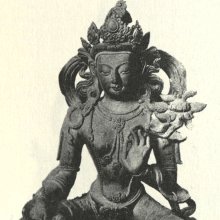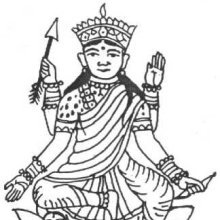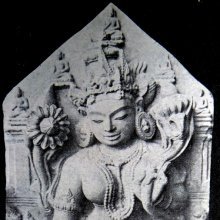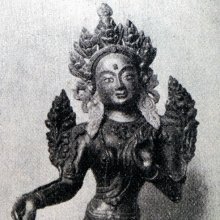Shyama, Śyāmā, Śyāma: 43 definitions
Introduction:
Shyama means something in Buddhism, Pali, Hinduism, Sanskrit, Jainism, Prakrit, Marathi, Hindi, biology. If you want to know the exact meaning, history, etymology or English translation of this term then check out the descriptions on this page. Add your comment or reference to a book if you want to contribute to this summary article.
Shyama has 43 English definitions available.
The Sanskrit terms Śyāmā and Śyāma can be transliterated into English as Syama or Shyama, using the IAST transliteration scheme (?).
Images (photo gallery)
Languages of India and abroad
Sanskrit dictionary
[Deutsch Wörterbuch]
Source: Cologne Digital Sanskrit Dictionaries: Böhtlingk and Roth Grosses Petersburger WörterbuchŚyāma (श्याम):—[Uṇādisūtra 1, 144.]
1) adj. (f. ā) schwarz, schwarzgrau, schwarzblau, schwarzgrün; = kṛṣṇa, nīla u.s.w. [Amarakoṣa 1, 1, 4, 23. 3, 4, 23, 145.] [Hemacandra’s Abhidhānacintāmaṇi 1397.] [Anekārthasaṃgraha 2, 338.] [Medinīkoṣa Manu’s Gesetzbuch 31. fg.] [Halāyudha 4, 49.] [VIŚVA] bei [UJJVAL.] zu [Uṇādisūtra] = harit [Amarakoṣa 3, 4, 23, 145.] [Hemacandra’s Anekārthasaṃgraha] [Medinīkoṣa] [VIŚVA a. a. O.] Yama's Hund [Atharvavedasaṃhitā 8, 1, 9.] [Taittirīyasaṃhitā 5, 7, 19, 1.] [Śāṅkhāyana’s Brāhmaṇa 2, 9.] [Pāraskara’s Gṛhyasūtrāṇi 1, 16. -] [Taittirīyasaṃhitā 7, 3, 18, 1.] [Taittirīyabrāhmaṇa 1, 3, 4, 4.] [Yāska’s Nirukta 4, 3.] [Prātiśākhya zum Ṛgveda 17, 9.] [The Śatapathabrāhmaṇa 5, 1, 2, 9. 2, 5, 8.] putra [14, 9, 4, 15.] śyāma iva pāpmā [Kāṭhaka-Recension 13, 6.] ayas Eisen [Atharvavedasaṃhitā 11, 3, 7.] anu cchya śyā.ena.tvacam [9, 5, 4.] śyāmācchabalaṃ (als nom. abstr.) prapadye [Chāndogyopaniṣad 8, 13. -] [Weber’s Indische Studien 8, 277. 10, 318.] [Meghadūta 58.] [Varāhamihira’s Bṛhajjātaka S. 3, 29. 8, 17. 33, 16. 34, 23. 47, 23. 80, 7.] [LAGHUJ. 2, 18.] [Kathāsaritsāgara 22, 182.] [Rājataraṅgiṇī 4, 1.] Erde [Suśruta 1, 135, 5.] Kuh [371, 17.] Pferd [Bhāgavatapurāṇa 1, 16, 12.] śyāmo lohitākṣo daṇḍaḥ [Manu’s Gesetzbuch 7, 25.] abhinavamadalekhāśyāmagaṇḍasthalānāṃ vāraṇānām [Spr. (II) 227.] stana [Meghadūta 18.] vilīnapallavaśyāmamukhau stanau [Kathāsaritsāgara 22, 5.] stanāvāśyāmacūcakau [34, 32.] śyāmayā cūcukatviṣā [120, 45.] uras [Bhāgavatapurāṇa 3, 15, 39.] karṇa (haya) [9, 15, 6.] śroṇi [4, 24, 51.] añjanabhṛṅga [Varāhamihira’s Bṛhajjātaka S. 64, 2.] vapus einer Wolke [Meghadūta 15.] nīlāmbuda [Mahābhārata 1, 5911.] prāvṛḍjaladhara [5928.] megha [Rāmāyaṇa 2, 83, 8.] [PAÑCAR. 1, 5, 3.] divasa ivārdhaśyāmaḥ (ivābhraśyāmaḥ v. l.) [Śākuntala 60.] udadhiśyāmasīmā dharitrī 48. snigdhaśyāmā daṇḍakāraṇyabhāgāḥ [UTTARAR. 32, 6 (42, 8).] vanabhūmayaḥ śyāmāstamāladrumaiḥ [Gītagovinda 1, 1.] phalapariṇatiśyāmajambūvanāntāḥ [Meghadūta 24.] kuravakaṃ śyāmaṃ dvayorbhāgayoḥ [Vikramorvaśī 26.] atasīkusuma [Varāhamihira’s Bṛhajjātaka S. 58, 32.] dūrvākāṇḍa [5, 58.] [Bhaṭṭikavya 5, 18.] dūrvā [Varāhamihira’s Bṛhajjātaka 2, 4.] indīvara [Mahābhārata 3, 1721.] [Harivaṃśa 7081.] [Rāmāyaṇa 2, 88, 14.] [Rāmāyaṇa] [Gorresio 2, 1, 41.] [Varāhamihira’s Bṛhajjātaka S. 24, 18.] [Bhāgavatapurāṇa 3, 26, 28.] nīlotpaladala [Rāmāyaṇa 4, 29, 9.] palāśa [Kathāsaritsāgara 21, 11.] śastrī [Pāṇini’s acht Bücher 6, 2, 2, Scholiast] [Śiśupālavadha 4, 44.] komalaśyāmaśaṣpa [Suśruta 1, 22, 18.] marakata [Bhāgavatapurāṇa 8, 6, 3. 16, 35.] Für schön gilt bei Männern und Frauen die durch śyāma bezeichnete Hautfarbe: rūpamatulaṃ sundaram [PAÑCAR. 1, 1, 3. 5, 3.] ayaṃ śyāmo mahābāhuḥ siṃhaskandho mahādyutiḥ [Mahābhārata 1, 5943. 3, 2450. 7, 2243. 5089.] [Rāmāyaṇa 2, 34, 1. 3, 42, 33.] [WEBER, Rāmatāpanīya Upaniṣad 294.] [Bhāgavatapurāṇa 1, 12, 8. 19, 28. 4, 7, 20.] dāsīsahasraṃ śyāmānām [Mahābhārata 3, 12711. 1, 5949. 3, 2664. 2754.] [Rāmāyaṇa 2, 61, 4. 3, 79, 20. 42.] [Meghadūta 80.] [Śiśupālavadha 8, 36.] [Spr. (II) 6542. fg.] [Kathāsaritsāgara 45, 334.] [Rājataraṅgiṇī 3, 413.] [Caurapañcāśikā 40.] [Mārkāṇḍeyapurāṇa 21, 18.] [PAÑCAR. 1, 4, 48.] Inschr. in [Journ. of the Am. Or. S. 7, 12], Einschiebung nach [Śloka 48.] śyāmā = yauvanamadhyasthā [UTPALA] bei [Mallinātha] zu [Śiśupālavadha 8, 36.] = aprasūtastrī [Hemacandra’s Anekārthasaṃgraha] [Medinīkoṣa] [VIŚVA a. a. O.] śīte sukhoṣṇasarvāṅgī grīṣme yā sukhaśītalā . taptakāñcanavarṇābhā sā strī śyāmeti kathyate .. Citat beim [Scholiast 2.] zu [Bhaṭṭikavya 5, 18. 8, 100]; vgl. [Spr. (II) 1850.] ghanaśyāma [Bhāgavatapurāṇa 6, 4, 37.] śyāmāvadāta [2, 9, 11. 3, 4, 7. 8, 18, 2.] [Rāmāyaṇa 5, 14, 23.] śyāmāruṇa [Varāhamihira’s Bṛhajjātaka S. 11, 24.] In [Varāhamihira’s Bṛhajjātaka S.] häufig śyāva als v. l. —
2) m. a) ein schwarzer Stier [Taittirīyasaṃhitā 1, 8, 8, 1. 2, 1, 4, 3.] [Aśvalāyana’s Śrautasūtrāni 9, 4, 6.] — b) der indische Kuckuck [Hemacandra’s Anekārthasaṃgraha] [Medinīkoṣa] — c) Bez. verschiedener Pflanzen: = vṛddhadāraka [Hemacandra’s Anekārthasaṃgraha] [Medinīkoṣa] [VIŚVA a. a. O.] = damanaka und gandhatṛṇa [Śabdakalpadruma] angeblich nach [VIŚVA]; = dhustūra, pīlu, śyāmāka [Rājanirghaṇṭa im Śabdakalpadruma] — d) Wolke [Hemacandra’s Anekārthasaṃgraha] [Medinīkoṣa] [VIŚVA] bei [UJJVAL.] — e) Nomen proprium α) eines Mannes gaṇa aśvādi zu [Pāṇini’s acht Bücher 4, 1, 110.] gaṇa śubhrādi zu [123.] eines Sohnes des Śūra und Bruders des Vasudeva [Harivaṃśa 1927. 1943. 5085.] [Viṣṇupurāṇa 437.] eines neueren Fürsten [ 8, 1 v. u.] — β) pl. einer Schule [Weber’s Indische Studien 3, 258.] — γ) eines Berges [Mahābhārata 6, 419.] — δ) einer für heilig erachteten Ficus indica [Hemacandra’s Anekārthasaṃgraha] [Medinīkoṣa] [VIŚVA. a. a. O.] [Rāmāyaṇa 2, 55, 7. 22.] [Raghuvaṃśa 13, 53.] [UTTARAR. 11, 8 (15, 11).] —
3) f. ā a) ein best. Vogel [Rājanirghaṇṭa im Śabdakalpadruma] [Varāhamihira’s Bṛhajjātaka S. 86, 37. 88, 1. 5. 14.] ruta [Weber’s Verzeichniss No. 896.] [Pañcatantra 157, 4.] = kokilā [Trikāṇḍaśeṣa 3, 3, 303.] = pika (vgl.
2) b) [VIŚVA a. a. O.] — b) Bez. verschiedener Pflanzen: = gundrā, priyaṅgu (die in [Hemacandra’s Anekārthasaṃgraha] und bei [VIŚVA] unterschieden werden) [Amarakoṣa 2, 4, 2, 35.] [Trikāṇḍaśeṣa] [Hemacandra’s Abhidhānacintāmaṇi 1149.] [Hemacandra’s Anekārthasaṃgraha] [Medinīkoṣa] [Halāyudha 2, 38.] [VIŚVA]; = sārivā [Amarakoṣa 2, 4, 3, 30. 3, 4, 23, 145.] [Hemacandra’s Anekārthasaṃgraha] [Medinīkoṣa] = pālindhī [Amarakoṣa 2, 4, 3, 27.] = trivṛt, vāgujī (vāguji) und nīlī [Hemacandra’s Anekārthasaṃgraha] [Medinīkoṣa] (kṛṣṇatrivṛtikā). und [VIŚVA]; = kṛṣṇā [Hemacandra’s Anekārthasaṃgraha] [VIŚVA]; = somalatā [Hemacandra’s Anekārthasaṃgraha] = śyāmalatā [VIŚVA]; = guḍūcī, kastūrī, vaṭapattrī, vandā, nīlapunarnavā, pippalī, haridrā, nīladūrvā, tulasī, kṛṣṇasārivā, śiṃśapā und padmabīja [Rājanirghaṇṭa im Śabdakalpadruma -] [Rāmāyaṇa 4, 29, 12.] [Suśruta 1, 59, 11. 139, 18. 144, 16. 162, 8. 2, 102, 11. 110, 12. 374, 15.] mūla [122, 5. 135, 1.] [Meghadūta 102.] [Spr. (II) 6044.] [Varāhamihira’s Bṛhajjātaka S. 54, 87. 55, 22. 85, 6.] — c) Nacht [Amarakoṣa 3, 4, 23, 145.] [Trikāṇḍaśeṣa 1, 1, 104.] [Hemacandra’s Abhidhānacintāmaṇi 142.] [Hemacandra’s Anekārthasaṃgraha] [Medinīkoṣa] [Halāyudha 1, 108.] [VIŚVA.] [Kāvyaprakāśa (II) 180, 1.] — d) Nomen proprium einer Frau: śyāmāyā āśramaḥ [Mahābhārata 13, 1716.] einer Tochter Meru's [Bhāgavatapurāṇa 5, 2, 22.] eine Form der Durgā [WILSON, Sel. Works 2, 78. 184.] [Oxforder Handschriften 93], b, [29. fg. 94], a, [44. fg.] b, [26. 96], a, [8. 101], a, [12.] rahasya [104], a, [27. 108], b, [No. 169.] [WILSON], Sel. Works [1, 250. 254. fgg. 262.] kalpalatā [Notices of Skt. Mss. 144.] kavaca [217.] nityapūjāpaddhati [179.] pradīpa [175.] ratna [213.] stotra [237. 269.] śyāmārcanacandrikā [116.] — Nomen proprium einer Göttin, die die Befehle des 6ten Arhant's ausführt, [Hemacandra’s Abhidhānacintāmaṇi 44.] Nomen proprium der Mutter des 13ten Arhant's 40. einer Fürstin [HALL] in der Einl. zu [VĀSAVAD. 52.] — e) Nomen proprium eines Flusses [Mārkāṇḍeyapurāṇa 59, 15.] ein Name der Yamunā [Medinīkoṣa] —
4) n. a) Pfeffer. — b) Seesalz [Hemacandra’s Anekārthasaṃgraha] [Medinīkoṣa] [VIŚVA.] — Vgl. priyaṅgu, maṇi, mahā, rakta (auch [Varāhamihira’s Bṛhajjātaka S. 69, 27]), śyāmāyana, śyāmeya .
Sanskrit, also spelled संस्कृतम् (saṃskṛtam), is an ancient language of India commonly seen as the grandmother of the Indo-European language family (even English!). Closely allied with Prakrit and Pali, Sanskrit is more exhaustive in both grammar and terms and has the most extensive collection of literature in the world, greatly surpassing its sister-languages Greek and Latin.
See also (Relevant definitions)
Starts with (+145): Shyama acarya, Shyama bhatta, Shyama ghash, Shyamaa, Shyamabala, Shyamabhadra, Shyamabhas, Shyamabhatta, Shyamacara, Shyamacaratantra, Shyamacarya, Shyamacataka, Shyamachara, Shyamadanta, Shyamadasa, Shyamadeva, Shyamadevi, Shyamadevipuja, Shyamadhumra, Shyamadi.
Ends with (+1): Abhrashyama, Ardhashyama, Ashyama, Ghanashyama, Jal shyama, Jayashyama, Kanjashyama, Kshudrashyama, Laghushyama, Mahashyama, Manishyama, Marakatashyama, Meghashyama, Nihshyama, Parishyama, Priyangushyama, Raktashyama, Shastrishyama, Shvetashyama, Sitashyama.
Full-text (+340): Shyamapuja, Shyamalata, Shyamanga, Shyamaka, Ghanashyama, Shyamita, Shyamala, Sama, Shyamaprakarana, Shyamapradipa, Shyamaprayogavidhi, Shyamarahasya, Shyamastotra, Shyamakalpalatika, Shyamaruta, Shyamapaddhati, Shyamamanasarcana, Shyamapujapaddhati, Shyamaratna, Shyamakavaca.
Relevant text
Search found 100 books and stories containing Shyama, Śyāmā, Śyāma, Syama, Syāma; (plurals include: Shyamas, Śyāmās, Śyāmas, Syamas, Syāmas). You can also click to the full overview containing English textual excerpts. Below are direct links for the most relevant articles:
Srila Gurudeva (The Supreme Treasure) (by Swami Bhaktivedanta Madhava Maharaja)
Rādhe Śyāma Śyāmā Śyāma < [Chapter 1.4 - Life in the Maṭha]
Establishing the proper chanting of the Mahā-Mantra < [Chapter 1.6 - Return to Maṭha Life]
Sahitya-kaumudi by Baladeva Vidyabhushana (by Gaurapada Dāsa)
Text 10.11 < [Chapter 10 - Ornaments of Meaning]
Text 9.3 < [Chapter 9 - Ornaments of Sound]
Text 5.14 < [Chapter 5 - Second-rate Poetry]
Garga Samhita (English) (by Danavir Goswami)
Verses 4.7.15-16 < [Chapter 7 - The Story of the Ayodhya Women]
Verse 5.20.16 < [Chapter 20 - The Liberation of Ṛbhu Muni During the Rāsa-dance Festival]
Verse 1.16.28 < [Chapter 16 - Description of Śrī Rādhikā’s Wedding]
Trishashti Shalaka Purusha Caritra (by Helen M. Johnson)
Part 9: Marriage with Gandharvaṣenā, daughter of Cārudatta < [Chapter II - Marriages of Vasudeva with maidens]
Part 4: Vimala’s birth and his birth-rites < [Chapter III - Vimalanāthacaritra]
Part 7: Marriage with Śyāmā and Vijayasenā < [Chapter II - Marriages of Vasudeva with maidens]
Chandogya Upanishad (english Translation) (by Swami Lokeswarananda)
Verse 8.13.1 < [Section 8.13]
Related products
(+3 more products available)










